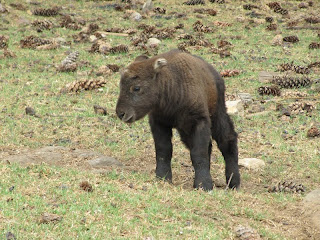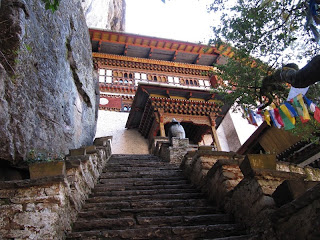




Woke up early and pretty excited for the Paro festival. From the hotel window we could see the locals heading up to the dzong in their finery. By the time we arrived at 8:30 the courtyard was absolutely packed and the dancing was already underway! Even looking at the crowd was great fun - everyone dressed in really bright colours and sitting anywhere there was even the faintest chance of a view. The local police were trying (fairly ineffectually) to get everyone surrounding the area to sit down to allow others to see. Luckily, being somewhat above the height of the average Bhutanese, we had some good views!
Most of the dances involve lavish costumes and masks. The first one was a demonstration of how to subdue demons (just in case you ever came across one). This seems to be a lengthy task involving much whirling, stamping, and slow motion movement. The next was a slightly more comprehensible parable on adultery with much slapstick humping and thwacking. Locals seemed to find it hilarious. It was nearly as funny watching their rapt expressions.
Apparently watching the dances counts as time towards your religious observances as a good Buddhist, so everyone was clocking up the reincarnation points.
We moved through the crowd seeking better vantage and ended up on the hill above the courtyard, surrounded by elderly Bhutanese all of whom were chewing betel nut. One old man insisted on trying on Olly's and Caroline's glasses in an effort to see the action better. No joy there then... They were very grateful for the close-ups afforded by the camera. We came to the conclusion that they couldn't actually see a thing!














































